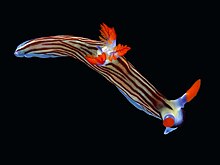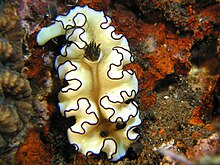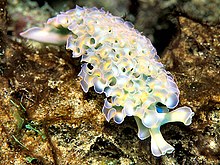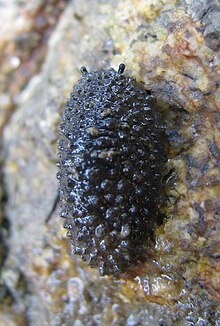Sea slug
[dummy-text]
Sea slug
Jump to navigation
Jump to search

The nudibranch Nembrotha aurea is a gastropod.

A sea cucumber also looks slug-like and is sometimes loosely called a "sea slug", but it is not a gastropod.
Sea slug is a common name for some marine invertebrates with varying levels of resemblance to terrestrial slugs. Most creatures known as sea slugs are actually snails, i.e. they are sea snails (marine gastropod mollusks) that over evolutionary time have seemingly lost their shells, due to having a greatly reduced or internal shell. The name "sea slug" is most often applied to nudibranchs, as well as to a paraphyletic set of other marine gastropods without obvious shells.[1]
True sea slugs have enormous variation in body shape, color, and size. Most are partially translucent. The often bright colors of reef-dwelling species implies that these are under constant threat of predators, but the color can serve as a warning to other animals of the sea slug's toxic stinging cells or offensive taste. Like all gastropods, they have small razor-sharp teeth, called radulas. Most sea slugs have two pairs of tentacles on their head used primarily for sense of smell, with a small eye at the base of each tentacle. Many have feathery structures (cerata) on the back, often in a contrasting color, which act as gills. All species of genuine sea slugs have a selected prey animal on which they specialize for food, including certain jellyfish, bryozoans, sea anemones, and plankton as well as other species of sea slugs.[2][3]
Contents
1 Shell-less marine gastropods
1.1 Gastropod groups
2 Diversity in sea slugs
3 References
Shell-less marine gastropods[edit]
The name "sea slug" is often applied to numerous different evolutionary lineages of marine gastropod molluscs or sea snails, specifically those gastropods that are either not conchiferous (shell-bearing) or appear not to be.[4] In evolutionary terms, losing the shell altogether, having a small internal shell, or having a shell so small that the soft parts of the animal cannot retract into it, are all features that have evolved many times independently within the class Gastropoda, on land and in the sea; these features often cause a gastropod to end up labeled with the common name "slug".

The nudibranch, Glossodoris atromarginata
Nudibranchs (clade Nudibranchia) are a large group of marine gastropods which have no shell at all. These may be the most familiar sort of sea slug, at least to scuba divers; nudibranchs, although most are not large, are often very eye-catching because so many of species have brilliant coloration. In addition to nudibranchs, a number of other taxa of marine gastropods (some easily mistaken for nudibranchs) are also often called "sea slugs".[5]
Gastropod groups[edit]
Within the various groups of gastropods that are called "sea slugs" numerous families are within the informal taxonomic group Opisthobranchia:
- The phrase "sea slug" is perhaps most often applied to nudibranchs, many of which are brightly patterned and conspicuously ornate.
- For two examples see the images of Nembrotha aurea and Glossodoris atromarginata within this article.
- The name "sea slug" is also often applied to the sacoglossans (clade Sacoglossa), the so-called sap-sucking or solar-powered sea slugs; these are frequently some shade of green.

The sacoglossan Elysia crispata

The cephalaspidean, Chelidonura varians
- Another group of main gastropods that are often labeled as "sea slugs" are the various families of headshield slugs and bubble snails within the clade Cephalaspidea.

The sea hare Aplysia dactylomela, photographed out of water
- The sea hares, clade Aplysiomorpha, have a small, flat, proteinaceous internal shell.
- The clades Thecosomata and Gymnosomata are small pelagic gastropods known as "sea butterflies" and "sea angels". Many species of sea butterflies retain their shells. These are commonly known as "pteropods" but are also sometimes called sea slugs; especially the Gymnosomata, which have no shell as adults.
There is also one group of "sea slugs" within the informal group Pulmonata:

The marine pulmonate Onchidella celtica
- One very unusual group of marine gastropods that are shell-less are the pulmonate (air-breathing) species in the family Onchidiidae, within the clade Systellommatophora.[6]
Diversity in sea slugs[edit]
Like many nudibranchs, Glaucus atlanticus can store and use stinging cells from its prey (Portuguese man o' war) in its finger-like cerata.
Other species like the Pyjama slug Chromodoris quadricolor may use their striking colors to advertise their foul chemical taste.
The lettuce sea slug (Elysia crispata) has lettuce-like ruffles that line its body. This slug, like other Sacoglossa uses kleptoplasty, a process in which the slug absorbs chloroplasts from the algae it eats, and uses "stolen" cells to photosynthesize sugars. The ruffles of the lettuce sea slug increase the slug's surface area, allowing the cells to absorb more light.
Headshield slugs like the Chelidonura varians use their shovel-shaped heads to dig into the sand, where they spend most of their time. The shield also protects sand from entering the mantle during burrowing.
The largest species of sea hare, the California black sea hare, Aplysia vaccaria can reach a length of 75 centimetres (30 in) and a weight of 14 kilograms (31 lb). Most sea hares have several defenses; in addition to being naturally toxic, they can eject a foul ink or secrete a viscous slime to deter predators.
References[edit]
^ Thompson, T. E. 1976. Biology of opisthobranch molluscs, vol. 1, 207 pp., 21 pls. Ray Society, no. 151.
^ Byatt, Andrew, Alastair Fothergill, and Martha Holmes. The Blue Planet: A Natural History of the Oceans. New York, NY: DK, 2001. Print. sea slugs
^ "sea slug". The Columbia Encyclopedia, 6th ed.. 2015. Encyclopedia.com. 10 Nov. 2015<http://www.encyclopedia.com>.
^ "Mating behaviour in the sea slug Elysia timida". BioMed Central Ltd. Retrieved 2014-05-02..mw-parser-output cite.citationfont-style:inherit.mw-parser-output .citation qquotes:"""""""'""'".mw-parser-output .citation .cs1-lock-free abackground:url("//upload.wikimedia.org/wikipedia/commons/thumb/6/65/Lock-green.svg/9px-Lock-green.svg.png")no-repeat;background-position:right .1em center.mw-parser-output .citation .cs1-lock-limited a,.mw-parser-output .citation .cs1-lock-registration abackground:url("//upload.wikimedia.org/wikipedia/commons/thumb/d/d6/Lock-gray-alt-2.svg/9px-Lock-gray-alt-2.svg.png")no-repeat;background-position:right .1em center.mw-parser-output .citation .cs1-lock-subscription abackground:url("//upload.wikimedia.org/wikipedia/commons/thumb/a/aa/Lock-red-alt-2.svg/9px-Lock-red-alt-2.svg.png")no-repeat;background-position:right .1em center.mw-parser-output .cs1-subscription,.mw-parser-output .cs1-registrationcolor:#555.mw-parser-output .cs1-subscription span,.mw-parser-output .cs1-registration spanborder-bottom:1px dotted;cursor:help.mw-parser-output .cs1-ws-icon abackground:url("//upload.wikimedia.org/wikipedia/commons/thumb/4/4c/Wikisource-logo.svg/12px-Wikisource-logo.svg.png")no-repeat;background-position:right .1em center.mw-parser-output code.cs1-codecolor:inherit;background:inherit;border:inherit;padding:inherit.mw-parser-output .cs1-hidden-errordisplay:none;font-size:100%.mw-parser-output .cs1-visible-errorfont-size:100%.mw-parser-output .cs1-maintdisplay:none;color:#33aa33;margin-left:0.3em.mw-parser-output .cs1-subscription,.mw-parser-output .cs1-registration,.mw-parser-output .cs1-formatfont-size:95%.mw-parser-output .cs1-kern-left,.mw-parser-output .cs1-kern-wl-leftpadding-left:0.2em.mw-parser-output .cs1-kern-right,.mw-parser-output .cs1-kern-wl-rightpadding-right:0.2em
^ Thompson, T. E., & Brown, G.H., 1984. Biology of opisthobranch Molluscs. Vol. 2. Ray Society; London. 1-229, p.49
^ "How sea slugs fall in love". Retrieved 2014-05-02.
Categories:
- Marine gastropods
- Mollusc common names
(window.RLQ=window.RLQ||).push(function()mw.config.set("wgPageParseReport":"limitreport":"cputime":"0.176","walltime":"0.250","ppvisitednodes":"value":286,"limit":1000000,"ppgeneratednodes":"value":0,"limit":1500000,"postexpandincludesize":"value":5672,"limit":2097152,"templateargumentsize":"value":72,"limit":2097152,"expansiondepth":"value":7,"limit":40,"expensivefunctioncount":"value":1,"limit":500,"unstrip-depth":"value":1,"limit":20,"unstrip-size":"value":7152,"limit":5000000,"entityaccesscount":"value":1,"limit":400,"timingprofile":["100.00% 197.379 1 -total"," 44.36% 87.549 1 Template:Reflist"," 36.90% 72.829 2 Template:Cite_web"," 27.41% 54.107 1 Template:Authority_control"," 18.19% 35.904 1 Template:For"," 7.25% 14.304 1 Template:Not_to_be_confused_with"," 1.17% 2.302 1 Template:Main_other"],"scribunto":"limitreport-timeusage":"value":"0.092","limit":"10.000","limitreport-memusage":"value":2405566,"limit":52428800,"cachereport":"origin":"mw1279","timestamp":"20190206061441","ttl":2073600,"transientcontent":false););"@context":"https://schema.org","@type":"Article","name":"Sea slug","url":"https://en.wikipedia.org/wiki/Sea_slug","sameAs":"http://www.wikidata.org/entity/Q7440127","mainEntity":"http://www.wikidata.org/entity/Q7440127","author":"@type":"Organization","name":"Contributors to Wikimedia projects","publisher":"@type":"Organization","name":"Wikimedia Foundation, Inc.","logo":"@type":"ImageObject","url":"https://www.wikimedia.org/static/images/wmf-hor-googpub.png","datePublished":"2004-03-24T21:02:13Z","dateModified":"2019-02-06T06:15:08Z","image":"https://upload.wikimedia.org/wikipedia/commons/3/3a/Nembrotha_aurea_B.jpg","headline":"group of marine invertebrates with varying levels of resemblance to terrestrial slugs"(window.RLQ=window.RLQ||).push(function()mw.config.set("wgBackendResponseTime":115,"wgHostname":"mw1271"););

